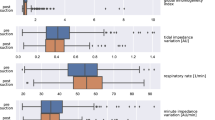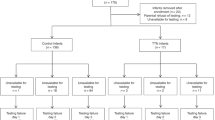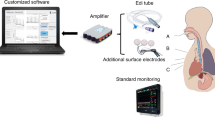Abstract
Objective:
The objective of the study was to compare thoracic fluid content (TFC) between newborn infants with and without respiratory distress. We tested the hypothesis that TFC would be higher in infants with respiratory distress.
Study Design:
A total of 96 newborn infants, gestational age 37.9 (2.6) weeks, were enrolled at birth. TFC by electrical bioimpedance was recorded within 3 h after birth (TFC1) and at 24 h of life (TFC2).
Results:
TFC1 was higher in infants with respiratory distress at birth (76.8 (24.9) versus 61.6 (16.1) 1 KOhm−1, P<0.0005). The association was independent from gestational age and mode of delivery. TFC2 was independently associated with respiratory distress at 24 h of life (adjusted coefficient b=0.5 (s.d. 0.02), P=0.02).
Conclusion:
TFC by electric bioimpedance independently correlated with the presence of respiratory distress at birth and at 24 h of life in late preterm and term newborn infants.
This is a preview of subscription content, access via your institution
Access options
Subscribe to this journal
Receive 12 print issues and online access
$259.00 per year
only $21.58 per issue
Buy this article
- Purchase on Springer Link
- Instant access to full article PDF
Prices may be subject to local taxes which are calculated during checkout


Similar content being viewed by others
References
Jain L, Eaton DC . Physiology of fetal lung fluid clearance and the effect of labor. Semin Perinatol 2006; 30: 34–43.
Yurdakok M . Transient tachypnea of the newborn: what’s new? J Matern Fetal Neonatal Med 2010; 23 (S3): 24–26.
Noori S, Drabu B, Soleymani S, Seri I . Continuous non-invasive cardiac output measurements in the neonate by electrical velocimetry: a comparison with echocardiography. Arch Dis Child Fetal Neonat Ed 2012; 97: F340–F343.
Grollmuss O, Demontoux S, Capderou A, Serraf A, Belli E . Electrical velocimetry as a tool for measuring cardiac output in small infants after heart surgery. Intens Care Med 2012; 38 (6): 1032–1039.
Grollmuss O, Gonzalez P . Non-invasive cardiac output measurements in low and very low birth weight infants: a method comparison. Front Pediatr 2014; 2: 16.
Torigoe T, Sato S, Nagayama Y, Sato T, Yamazaki H . Influence of patent ductus arteriosus and ventilators on electrical velocimetry for measuring cardiac output in very low/low birth weight infants. J Perinatol 2015; 35 (7): 485–489.
Song R, Rich W, Kim JH, Finer NN, Katheria AC . The use of electrical cardiometry for continuous cardiac monitoring in preterm neonates: a validation study. Am J Perinatol 2014; 31 (12): 1105–1110.
Lien R, Hsu KH, Chu JJ, Chang YS . Hemodynamic alterations recorded by electrical cardiometry during ligation of ductus arteriosus in preterm infants. Eur J Pediatr 2015; 174 (4): 543–550.
Hsu KH, Wu TW, Wang YC, Lim WH, Lee CC, Lien R . Hemodynamic reference for neonates of different age and weight: a pilot study with electrical cardiometry. J Perinatol 2016; 36 (6): 481–485.
van de Water JM, Mount BE, Chandra KM, Mitchell BP, Woodruff TA, Dalton ML . TFC (thoracic fluid content): a new parameter for assessment of changes in chest fluid volume. Am Surg 2005; 71 (1): 81–86.
Folan L, Funk M . Measurement of thoracic fluid content in heart failure: the role of impedance cardiography. AACN Adv Crit Care 2008; 19 (1): 47–55.
Liu J, Chen XX, Li XW, Chen SW, Wang Y, Fu W . Lung ultrasonography to diagnose transient tachypnea of the newborn. Chest 2016; 149 (5): 1269–1275.
Rawlings JS, Smith FR . Transient tachypnea of the newborn: an analysis of neonatal and obstetric risk factors. Am J Dis Child 1984; 138: 869–871.
Osypka MJ, Bernstein DP . Electrophysiologic principles and theory of stroke volume determination by thoracic electrical bioimpedance. AACN Clin Issues 1999; 10 (3): 385–399.
Berger PJ, Smolich JJ, Ramsden CA, Walker AM . Effect of lung liquid volume on respiratory performance after casesarean delivery in the lamb. J Physiol 1996; 1 (492): 905–912.
Brat R, Yousef N, Klifa R, Reynaud S, Shankar Aguilera S, De Luca D . Lung ultrasound score to evaluate oxygenation and surfactant need in neonates treated with continuous positive airway pressure. JAMA Pediatr 2015; 169 (8): e151797.
Cassady G . Effect of cesarean section on neonatal body water spaces. N Engl J Med 1971; 285 (16): 887–891.
Author information
Authors and Affiliations
Corresponding author
Ethics declarations
Competing interests
The authors declare no conflict of interest.
Rights and permissions
About this article
Cite this article
Paviotti, G., De Cunto, A., Moressa, V. et al. Thoracic fluid content by electric bioimpedance correlates with respiratory distress in newborns. J Perinatol 37, 1024–1027 (2017). https://doi.org/10.1038/jp.2017.100
Received:
Revised:
Accepted:
Published:
Issue Date:
DOI: https://doi.org/10.1038/jp.2017.100
This article is cited by
-
Thoracic fluid content (TFC) using electrical cardiometry versus lung ultrasound in the diagnosis of transient tachypnea of newborn
European Journal of Pediatrics (2024)
-
Impact of patent ductus arteriosus on non-invasive assessments of lung fluids in very preterm infants during the transitional period
European Journal of Pediatrics (2023)
-
Tools for assessing lung fluid in neonates with respiratory distress
BMC Pediatrics (2022)
-
Prediction of respiratory distress severity and bronchopulmonary dysplasia by lung ultrasounds and transthoracic electrical bioimpedance
European Journal of Pediatrics (2022)
-
Bioreactance-derived haemodynamic parameters in the transitional phase in preterm neonates: a longitudinal study
Journal of Clinical Monitoring and Computing (2022)



